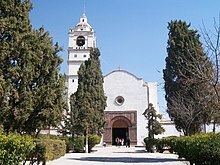Denomination Roman Catholic Status Parish | Consecrated 1590 | |
 | ||
Similar San Nicolás Tolentino, Monumental Clock of Pachuca, Acuario Inbursa, Zoológico Miguél Álvarez d, Africam Safari | ||
Santiago Apóstol parish is the Catholic church and parish house of the people of Santiago Tequixquiac town. Has always belonged to the Diocese of Cuautitlan in Mexico dedicated to Saint James Apostle; also is a sanctuary where they worship the image of Lord of the Chapel. This church is located in the center of town, near Plaza Cuauhtemoc next to the Avenida Juárez. This colonial building is a monument of great architectural importance has lasted until today in the Municipality of Tequixquiac.
Contents
History
The viceregal government justified this by religious orders means in Teotlalpan. They had the Franciscans build new chapels built on the various encomiendas and settled the Chichimeca Indians around these. One of these chapels was the Temple of Santiago Tequixquiac which had authority over the new villages of San Mateo Hueycalco, San Sebastián Tlalachco, San Fransico Apazco and others, by Mexico City Archbishop order. This first Christian temple was constructed in 1569 but was destroyed by indigenous rebellion. It became a formal parish in 1590, the first priest was a Spanish Franciscan, Juan Arias de León.
In 1650 was instituted, the commissioner of the Inquisition of New Spain in Tequixquiac town, in charge of the priest Nicolás de Arellano, for to address all issues of importance on the behavior of people around the parish and other towns. Here judgments were dictated against principally to Spaniards and Mestizos. In this temple no bloody executions were carried out, it was just in comisarías to determine autos de fe to any, to act as mediator between qualities (races) to avoid bad habits, land disputes and boundaries, irregularities in jobs and tax revenue about mines. The problems considered serious were referred to the Palace of the Santo Oficio or Inquisitor Palace in Mexico City; the causes of condemnation were bigamy, theft, murder, taxes evasion, sodomy, naughtiness to the Roman Catholic Church, Sephardic or Jewish practices or witchcraft.
In this region was there lime mines and stone mines for construction and one of the most common complaints was the exploitation of indigenous people, these was forced in labor and mistreatment who often ended in deaths and clashes. Felix de Peñafiel was a priest who redacted the Suma de Visitas in this parish for the Archbishop, this documents tell about the number of inhabitants in the instances, the dimension on Christian doctrine was taught in Spanish, Nahuatl and Otomi, complaints about lands, and the relation of baptisms and attendance at other religious services.
During a drought, a sculpture of the "Señor de la Capilla" (Our Lord of the Chapel) was brought over to Tequixquiac from Apaxco. When the drought broke, the image was not returned, presumably because it was made of fiber and had grown too heavy to carry. From then on, it has stayed in this town and many miracles have been attributed to it.
After the independence of Mexico, all public affairs are conducted inside the temple with the assistance of the people to celebrations, there elected the first mayor of Tequixquiac municipality in 1826, voting also in this place, in 1851, to create the guard that protect the inhabitants and ways with young men over 16 years because the army could not protect the people by armed conflicts that were to emerge in the country.
Architecture
This temple was constructed in various phases, the workforce was indigenous and the architectonic design was in charge of the religious; this architecture style is named tlaquitqui, because in some elements there are indigenous symbols and concepts.
The facade contains two doorways that are elaborately decorated in stonework which contains indigenous symbolism as well. The temple and the town are dedicated to the Apostle James.
This temple have got a great counterforts for to support the vault and dome in form of a Latin cross, the walls are thick so that the temple was a fortification in case of indigenous rebellions. There is a strong Moorish influence both the structure and tower, which has a similtud forms with minarestes of Islamic art in towers.
The atrium was a large space encased in stone with a cross on top of it but with Christian and indigenous symboles mixed on its walls. In each of its four corners there are wells and in the center there is an open space with Solomonic columns.
Picture
This temple has got Baroque masterpieces, the pictures were painted in the XVI and XVII centuries, the principal themes are San Miguel Archangel, El sagrado de corazón de Jesús, las animas del purgatorio.
The murals in this temple are in the domes. In the sacristy, inside of the dome, was painted La crucificción de Jesucristo (Jesus Christ's crucifixion), the dome symbolize the heaven, where looking the event by angels, cherubs and saints, to center the image when Christ is crucified downloading from the cross.
Dance
The Contradanza de las Varas is a traditional creole dance that is performed in the town celebrations of this temple, not based on indigenous dances. This is a traditional dance that was danced only men in 25 July in honor of the apostle James since 1652, and that the settlers religious evangelizers taught in the Christian faith in devotion to God. Years later was in honor of the Lord of Chapel. The name of contradanza comes from the use of two rose sticks (rosa gallica) that have colored ribbons with figures that become the rhythm of the dance steps.
Other dance is La Trenza, this is danced only Mondays in Lord of the Chapel fair, is a colored pole with braided ribbons with the march of the band music.
